RESUMEN DE PROCESOS DE RECICLAJE Y REUSO DE LOS DESECHOS DEL RASPADO DE WET-BLUE.
Contenido principal del artículo
Resumen
Las curtiembres son industrias muy contaminantes que liberan compuestos peligrosos, como el cromo, en sus efluentes sólidos y líquidos y gases derivados de la descomposición orgánica en sus efluentes gaseosos, los cuales se liberan al medio ambiente. Según lo que se ha encontrado en bibliografía se puede notar que todos los vertidos sólidos van a parar a los vertederos; mientras, que los efluentes líquidos son tratados, hasta cumplir normas ambientales locales y luego son eliminados en los ríos más cercanos. Es indispensable que se desarrollen tecnologías ecosostenibles e innovadoras para el manejo y eliminación de estos desechos. Pero como el wet-blue es tan estable químicamente, el desarrollo de nuevas tecnologías de reciclaje y/o reúso estos residuos de curtiembres se está convirtiendo en un gran desafío para los investigadores. En la actualidad, los encargados de estudiar estos residuos han empezado a utilizar estos desechos para producir nuevos materiales que simulen las cualidades del cuero o tecnologías que permitan extraer colágeno del wet-blue de la forma más económica. Existen varios trabajos sobre la gestión de residuos de cuero y los que se han utilizado para elaborar este resumen, informan de manera concisa los procesos que se utilizan para reutilizar y/o reciclar el wet-blue. Esta revisión informa por primera vez el estado del arte de las estrategias relacionadas con la recuperación y valorización de estos residuos de cuero y la obtención de colágeno hidrolizado a partir de ellos. En la sección de conclusiones, los autores brindan implicaciones prácticas para la industria con relación al reciclaje del wet-blue.
Descargas
Detalles del artículo

Esta obra está bajo una licencia internacional Creative Commons Atribución 4.0.


